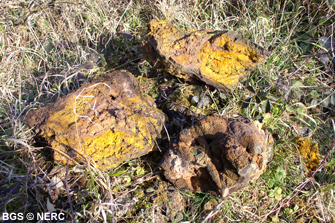
Minerals and mines
Introduction | History
of lead mining | History
of zinc mining | Lead
ore & mines
Zinc ore & mines | Iron
ore, ochre & mines | Coal mining
Iron ore and ochre mines
Types of Iron ore

Iron ore is most commonly found as haematite (Fe2O3), pyrite (FeS2) and goethite (FeO.OH), or as a mixture of hydrated iron oxides known as limonite. In the Mendips, haematite and goethite commonly occur together as either massive, granular, often siliceous masses, or as altered, amorphous, loosely compacted, earthy varieties known as ochre. Two type of ochre occur: red ochre, which is mostly impure earthy haematite; and yellow ochre which is earthy goethite, clay and other iron hydroxides. Ochre can take a variety of forms depending on its mode of deposition. It often occurs as encrusting, botryoidal or stalatitic forms.
Manganese is a common mineral associated with iron and ochre deposits, and is typically found as dull black, soft oxides known as ‘wad’, a mixture chiefly of pyrolusite (MnO2) and psilomelane, another manganese oxide.
Mineralisation
Unlike the lead and zinc ores, many of the iron ore deposits are secondary deposits. Intense weathering of the iron pyrite-rich Coal Measures, and other iron bearing rocks during Permian and Triassic times released the iron into the groundwater. The iron was subsequently redeposited as many thin discontinuous veins of haematite or pyrite, within the Carboniferous Limestone and the Dolomitic Conglomerate, and especially along the unconformity between the two. Many of these pyrite veins have now been altered to form limonite or ochre. Ochre also occurs infilling cavities in the Carboniferous Limestone and Dolomitic Conglomerate, or as a replacement ore-body, where metal-rich ground-waters have chemically replaced the host rock with iron ore.
Following deposition, solutional lowering of the limestone has caused the iron-rich ore to accumulate in the subsoil. Some of this material has then sludged into caves and open fissures. Many of the ochre deposits are actually cave fillings, and splendid examples of these can be seen above Shute Shelve on Axbridge Hill.
Orefields
Haematite has been mined here and there throughout the Mendips, but the lower grade ochre ores are especially common in the hills surrounding Winscombe and the Lox Yeo Valley. Ochre was being mined on Axbridge Hill in the 1920s, and old workings exist on Banwell Hill and on the northern side of Sandford Hill. Most of the ore was mined from small shallow pits and adits. A large ochre mine, now in a state of collapse was worked at Compton Martin. Various types of iron ore, and some rare oxychlorides of lead, were worked from a mine at Higher Pitts Farm near Wookey Hole.
Small amounts of manganese was worked for paint making in the Wadbury valley near Mells, around Harptree and elsewhere.
- Home
- Overview maps
- Locality
areas
- Cheddar Gorge
- Charterhouse
- Blackdown
- Burrington Combe
- Shipham & Rowberrow
- Crook Peak & Axbridge
- Banwell to Churchill
- Priddy
- Harptree & Smitham Hill
- Draycott & Westbury-sub-Mendip
- Wookey Hole & Ebbor Gorge
- Wells
- Great Elm & Vallis Vale
- Mells & the Wadbury Valley
- The Vobster area
- The Whatley area
- Torr Works & Asham Wood
- Beacon Hill
- Stoke St Michael & Oakhill
- Holwell & Nunney
- Shepton Mallet & Maesbury
- Gurney Slade & Emborough
- The Nettlebridge valley
- Geology
- Minerals and mines
- Quarrying
- Caves and karst
- Biodiversity
- Detailed site information
- Acknowledgements
- External links
- Search
- Site map